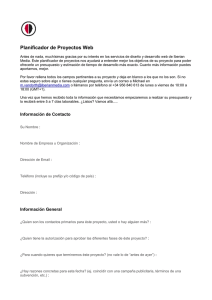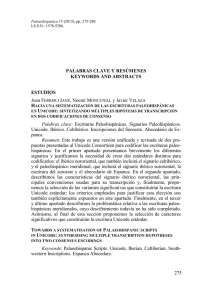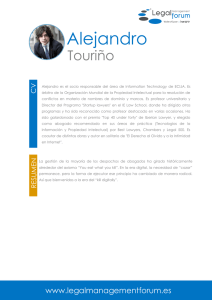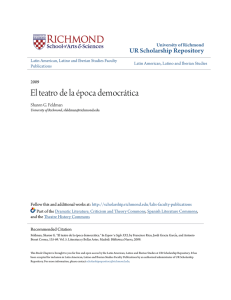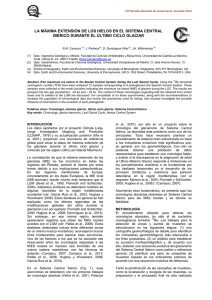21. Resúmenes de los estudios
Anuncio
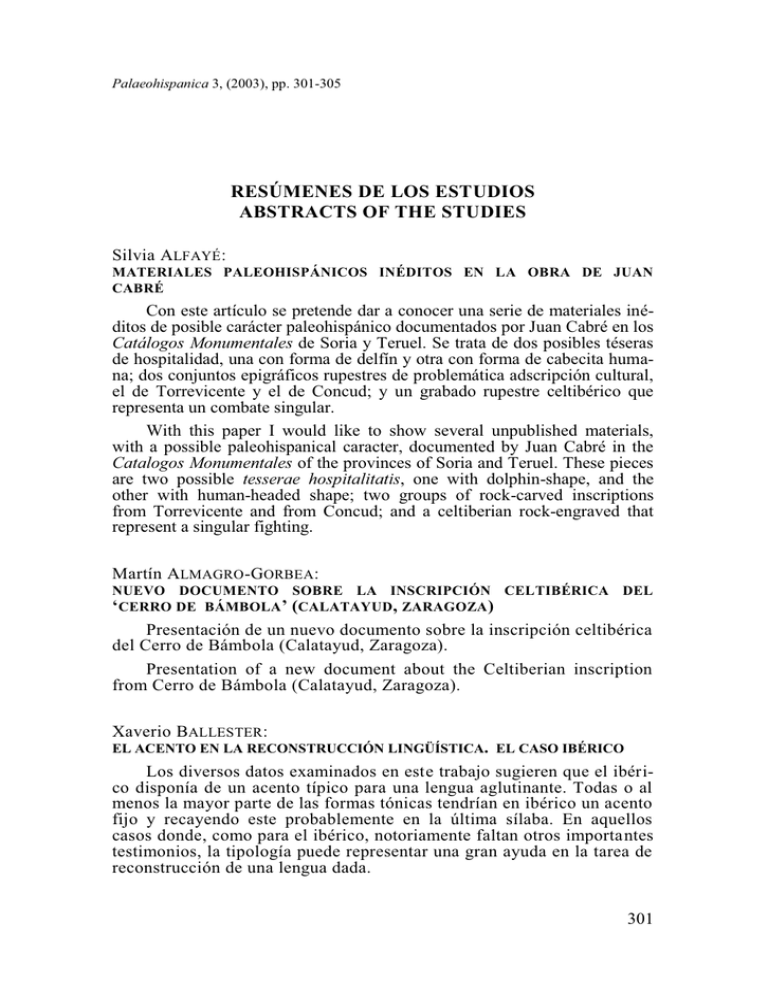
Palaeohispanica 3, (2003), pp. 301-305 RESÚMENES DE LOS ESTUDIOS ABSTRACTS OF THE STUDIES Silvia ALFAYÉ: MATERIALES PALEOHISPÁNICOS INÉDITOS EN LA OBRA DE JUAN CABRÉ Con este artículo se pretende dar a conocer una serie de materiales inéditos de posible carácter paleohispánico documentados por Juan Cabré en los Catálogos Monumentales de Soria y Teruel. Se trata de dos posibles téseras de hospitalidad, una con forma de delfín y otra con forma de cabecita humana; dos conjuntos epigráficos rupestres de problemática adscripción cultural, el de Torrevicente y el de Concud; y un grabado rupestre celtibérico que representa un combate singular. With this paper I would like to show several unpublished materials, with a possible paleohispanical caracter, documented by Juan Cabré in the Catalogos Monumentales of the provinces of Soria and Teruel. These pieces are two possible tesserae hospitalitatis, one with dolphin-shape, and the other with human-headed shape; two groups of rock-carved inscriptions from Torrevicente and from Concud; and a celtiberian rock-engraved that represent a singular fighting. Martín ALMAGRO -GORBEA: NUEVO DOCUMENTO SOBRE LA INSCRIPCIÓN CELTIBÉRICA DEL µCERRO DE BÁMBOLA¶ (CALATAYUD, ZARAGOZA ) Presentación de un nuevo documento sobre la inscripción celtibérica del Cerro de Bámbola (Calatayud, Zaragoza). Presentation of a new document about the Celtiberian inscription from Cerro de Bámbola (Calatayud, Zaragoza). Xaverio BALLESTER: EL ACENTO EN LA RECONSTRUCCIÓN LINGÜÍSTICA. EL CASO IBÉRICO Los diversos datos examinados en este trabajo sugieren que el ibérico disponía de un acento típico para una lengua aglutinante. Todas o al menos la mayor parte de las formas tónicas tendrían en ibérico un acento fijo y recayendo este probablemente en la última sílaba. En aquellos casos donde, como para el ibérico, notoriamente faltan otros importantes testimonios, la tipología puede representar una gran ayuda en la tarea de reconstrucción de una lengua dada. 301 Resúmenes de los Estudios The different data dealt with by the author suggest that the Iberian language had a typical agglutinative accent. All or most Iberian words had a fixed accent probably falling on the last syllable. Linguistic r econstruction typology may be of help for philologists especially when there is an apparent gap in important data as is the case of Iberian. Miguel BELTRÁN: LOS MORTEROS µ BILINGÜES ¶ DEL VALLE DEL EBRO Se presenta una nueva interpretación para la transcripción de las estampillas ³bilingües´ sobre morteros de imitación de la forma Emporiae 36,2, fabricados en el valle del Ebro a comienzos del siglo I a.C. Se concluye, con base en modelos epigráficos propios del suelo itálico, en el carácter de complementariedad de dichos sellos, que expresan asociaciones comerciales de productores itálicos e ibéricos a través de personajes serviles (officinatores) que figuran al frente de las producciones de morteros, siguiendo la fórmula de exercere negotiationes per servos, forma de producción documentada en otros ámbitos del mundo romano en época tardorrepublicana. This paper deals with a new interpretation of ³bilingual´ stamps on some mortars which were produced at the beginning of the Ist century BC in the mid Ebro valley imitating the shape of Emporiae 36,2 mortars. According to epigraphic Italic parallels, these bilingual stamps are understood as complementary texts refering to a commercial partnership among Italian and Iberian producers by means of slaves (officinatores) who are in charge of the workshops, that is exercere negotiationes per servos, a wellknown model in the Roman world during the Late Republic. Javier DE HOZ: EL LÉXICO MINERO DE PLINIO Y SU POSIBLE ORIGEN HISPANO Estudio del léxico minero no latino y probablemente hispano en la obra de Plinio. Study of the mining vocabulary of probable non Latin but Hispanic origin in PliniXVWKH(OGHU¶VNH. Amilcar GUERRA: ALGUMAS QUESTÕES PENINSULAR DE TOPONÍMIA PRÉ-ROMANA DO OCIDENTE A partir del análisis de la documentación literaria y epigráfica de los topónimos y etnónimos del occidente hispánico, se pretende poner de relieve la conveniencia de la comparación de ambos tipos de fuentes. Se abordan, por un lado, varios problemas específicos de naturaleza lingüística, relativos a la fijación de algunas formas onomásticas y a la flexión de los nombres. Luego se hacen algunas consideraciones de carácter histórico-cultural que se pueden extraer de ellos y se abordan cuestiones de localización de las entidades referidas. Por último, se establecen algunas relaciones con la toponi302 PalHisp 3 Resúmenes de los Estudios mia moderna, contribuyendo así a dar mayor consistencia a las hipótesis presentadas. From the analysis of some place-names and ethnic-names of the Western areas of the Iberian Peninsula, which appear in literary and epigraphic documents, the usefulness of comparing both types of sources is established. In the first place, several specific problems of a linguistic nature, such as the fixation of some onomastic forms and the flexion of some names are discussed. Second, taking into account several historical and cultural considerations which derive directly from the problems discussed in the first section, I suggest reconsidering the localization of the forms analyzed. Finally, some relations between these forms and some modern place-names are established as to offer additional support to the thesis defended here. Carlos J ORDÁN CÓLERA: ACERCA DEL ABLATIVO QUE HOSPITALIDAD CELTIBÉRICAS APARECE EN LAS TÉSERAS DE El autor ofrece una nueva interpretación del ablativo que aparece en algunas téseras celtibéricas: es una uariatio de la expresión más usada, el adjetivo toponímico. Ambas indicarían la población que otorgaba la kar. Habría una tercera posibilidad, la indicación mediante el genitivo plural del localicio. Quizá también esté testimoniada una cuarta variante, el genitivo singular del topónimo. The author of this paper offers a new interpretation of the ablative that DSSHDUVLQVRPHFHOWLEHULDQWHVVHUDHLW¶VDuariatio of the most used expression, the toponymic adjective. Both would indicate the city that conceded the kar. It would be a third way, the genitive of the ethnic name in plural. Perhaps there is a fourth manner, the genitive singular of the place-name. Eugenio LUJÁN: EN TORNO A LA IDENTIFICACIÓN DE LA CECA IKALE ( N) SKEN A.95) (MLH Propuesta de una nueva localización de la ceca ikale(n)sken (MLH A.95). This paper provides a new identification of the nimt ikale(n)sken (MLH A.95). Eduardo ORDUÑA AZNAR : SOBRE DOS POSIBLES TOPÓNIMOS EN UN PLOMO IBÉRICO DEL CAMP DE MORVEDRE Este artículo trata de mostrar la posible relación entre las palabras ibéricas arsboiltiĚ y etem²iltiĚ, en un plomo encontrado en el Camp de Morvedre, y los topónimos Arse (Sagunto) y Edeta (Cerro de Sant Miquel de Llíria), respectivamente. PalHisp 3 303 Resúmenes de los Estudios This paper tries to show the posible relationship between the iberian words arsboiltiĚ and etem²iltiĚ, in a lead found in the Camp de Morvedre, and the place-names Arse (Sagunto) and Edeta (Cerro de Sant Miquel de Llíria), respectively. Fransciso J. RUBIO ORECILLA: ACERCA DE VIEJAS Y NUEVAS INSCRIPCIONES En este trabajo se analizan las posibles segmentaciones de kamasiosuei ikenionke setantunos; así, se separa un NP kamasio (gen.sg.) de un reflexivo suei; ikenionke puede ser un abl. sg. con pérdida de -z, o quizá haya que OHHU ikenion[tes] ke[nteis]. Para el NP setantunos se propone como base derivación *seȤtam ³VLHWH´ FRQ XQD IRUPDFLyQ *seȤtan-to- que tiene otros paralelos en la onomástica celtibérica (suostun-, nouanto-). Para K.0.13 se propone la lectura tuinikukuei kortonikum kar; la mejor alternativa parece ser la identificación de kuei como nom. sg. de un indefinido enclítico, cognado del nom. sg. interrogativo NX֒HL֒ > irl. ant. cía. Y en ]rkue|Tutai | batikan|toulo|izui se identifica una 3ª pl. tikan(to), en relación con -tinkounei, -tiseti del BB.I. El sujeto de tikan(to) sería el pl. ntr. utaiba;T es un signo numérico, y si no es un cardinal, quizá Tuta HTXLYDOJDDkX֒etr>XWƗ u oȤt>njWƗ³JUXSRGHFXDWURJUXSRGHRFKR´ In this paper for kamasiosuei ikenionke setantunos possible segmentations are analysed; so a PN kamasio (gen.sg.) is isolated from the reflexiv form suei; ikenionke could be an abl. sg. with lack of the ending -z, if we GRQ WPXVWUHDGikenion[tes] ke[nteis]. For the PN setantunos *seȤtam ³VHYHQ´ LV SURposed as derivation basis, in a word-formation *seȤtan-to- with other parallels in the Celtiberian onomastics (suostun-, nouanto-). For K.0.13 the lection tuinikukuei kortonikum kar is proposed, where the best of the choices seems to be the identification of kuei as sg. nom. of a indefinite enclitic pronoun, cognate of the sg. nom. interrogative NX֒eL֒ > oi. cía. In ]rkue | T utai | batikan | toulo | izui a 3th pl. tikan(to) is identificated, in connection with the verbal forms -tinkounei, -tiseti of BB.I. The subject of tikan(to) would be utaiba, if pl. ntr.; T is a numerical sign, and if it is not a cardinal, perhaps Tuta VKRXOG EH UHDG kX֒etr>XWƗ RU oȤt>njWƗ ³TXDUWHW RFWHW´ Luis SILGO GAUCHE: (D.10.1) Una nueva interpretación de la estela ibérica de Fraga (D.10.1). A new interpretation of the iberian stele from Fraga (D.10.1). LA ESTELA IBÉRICA DE FRAGA 304 PalHisp 3 Resúmenes de los Estudios Alicia TORIJA: ALGUNAS CONSIDERACIONES PARA EL ESTUDIO DE LA EPIGRAFÍA IBÉRICA SOBRE VAJILLA DE PLATA : EL CUENCO DEL ALCORNOCAL La vajilla de plata (cuencos, páteras, vasos) es uno de los soportes sobre los que con relativa frecuencia se han inscrito textos en lengua ibérica. En este artículo se analizan de una parte cuestiones referentes al método utilizado en su estudio, de otra la novedad que supone realizar la autopsia de las piezas con la ayuda de una lupa binocular. Por último, se ha elegido un caso práctico: la pieza conocida desde el siglo XIX y que se conserva en el Museo Arqueológico Nacional llamada del Alcornocal. Texts written in Iberian language are often found engraved on silverware (silver bowls, vessels). The purpose of this contribution is on the one hand to analyze questions of method as applied to the study of these inscriptions, and on the other to report the innovation brought about with the use of a dissecting microscope (a binocular magnifying glass) to examine the texts. Finally, a case-study is presented: a well-known piece, generally called El Alcornocal, preserved at the Museo Arqueológico Nacional. Javier VELAZA: LA EPIGRAFÍA IBÉRICA EMPORITANA: BASES PARA UNA RECONSIDERACIÓN El propósito de este trabajo es analizar las inscripciones ibéricas emporitanas en relación con sus contemporáneas griegas y latinas. La exacta correlación entre soportes, técnicas y funciones de la escritura invita a considerar el hecho epigráfico como un fenómeno unitario que encuentra expresión en las tres lenguas. The purpose of this work is to analyze Iberian inscriptions from Empúries by means of their relationship with contemporary Greek and Latin inscriptions. The exact correlation between suports, technics and scripturary functions brings to consider the epigraphical fact as a unitary phenomenon which found expression in three different languages. PalHisp 3 305



